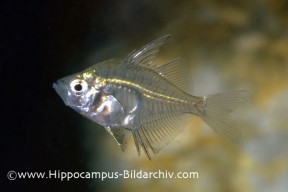Parambassis ranga
Indian Glass Fish
Classification
Ambassidae
Distribution
India, Pakistan, Nepal, Bangaldesh, Myanmar, Thailand, Malaysia, Cambodia, Japan.
Habitat
It usually inhabits areas of slow moving or still water.
Maximum Standard Length
3.2″ (8cm).
Aquarium SizeTop ↑
An aquarium with dimensions of 80 ∗ 30 ∗ 30 cm or equivalent should be the smallest considered.
Maintenance
A dark substrate will help to make this shy species less nervous and encourage it to display its best colours. Provide cover by planting some areas of the tank densely, along with some floating vegetation. Rocks and driftwood can also be used. The fish can live in both freshwater and slightly brackish conditions.
Water Conditions
Temperature: 68-86°F (20-30°C)
pH: 6.5-8.0
Hardness: 8-20°H
Diet
Relatively unfussy and will accept most live, frozen and dried foods.
Behaviour and CompatibilityTop ↑
P. ranga is peaceful and shy and should not be combined with vigorous or aggressive species. The choice of tankmates is also governed by the type of water in which it is being kept. In freshwater conditions, it can be kept with barbs, livebearers, smaller rainbowfish, loaches and many other small tropicals. In the brackish aquarium, mollies, bumblebee gobies and chromides are all possibilities.
The Indian glass fish is a shoaling species and will not do well if kept singly or in pairs. Aim for a group of at least 6. Males do become somewhat territorial when spawning but physical damage is rare.
Sexual Dimorphism
Males have blue edging to the dorsal and anal fins and are a slightly deeper yellow on the body than females. These differences are more apparent when the fish are breeding, as the colours become more intense. The swim bladder (which is clearly visible) has a pointed back edge in males.
Reproduction
Not too difficult, although the fry are difficult to raise. Provide the fish with a heavily planted aquarium of around 30″ x 12″ x 12″. Stock it with 6-8 adult fish. It is an advantage if the tank is situated so that it recieves direct sunlight in the morning. Condition the group with a high quality, varied diet. During this period, maintain them at a temperature of around 70-75°F. A pH around neutral should be fine.
When the fish are inbreeding condition (look for an intensifying of the colours of the males, and round bellies on the females), perform a large water change with warmer water (around 80-84°F) in the evening. The fish should spawn the following morning. Each pair may deposit up to 200 eggs, and these will be found amongst the vegetation, stuck to plant leaves and stems. The adult fish can be removed at this point.
The eggs are very sensitive to fungussing and the entire tank should be dosed with a weak solution of methylene blue, or similar, in order to prevent this. They will hatch in around 24 hours and will be seen hanging from the plants. They become free swimming in another 3-4 days. They are quite difficult to raise, as they do not actively seek food. Instead they wait for morsels to drift by. We suggest feeding quite heavily with brine shrimp nauplii and creating a slow current in the tank. Regular small water changes will be required in order to keep the water conditions perfect.
NotesTop ↑
Previously known as Chanda ranga, the common name of this species arose because it’s translucent skin means that the bone structure and internal organs are clearly visible. For many years it has been artificially injected with luminous dyes on fish farms in Asia and then sold as “Painted” glass fish or “Disco fish”. This abhorrent act involves injecting the fish repeatedly with a large needle and most fish do not survive more than a few months afterwards. Whilst painted fish of this and other species are still available in many countries, protracted campaigning has seen them virtually removed from UK stores.
Now to dispel a myth about glass fish. According to most resources (including the majority of internet sites), this species requires the addition of salt to its water to keep it at it’s best, often stating that it is susceptible to fungal infections when kept in freshwater. This is simply not true. Whilst the fish can indeed be acclimatised to mildly brackish water (and are found in brackish conditions in some of their habitats in nature), it is found most often in freshwater. Additionally, many of these freshwater habitats actually contain quite soft, acidic water. When purchasing this fish, ask your dealer what conditions they are being kept in. If they are in freshwater, don’t be tempted to add salt to the tank when you get home, as there is no need.
It is not inconceivable that a combination of the brackish myth, the susceptibility of the painted fish to disease and the fact that this is quite a short-lived species have given rise to the commonly held belief that this fish is hard to keep. In reality, it is a pretty and peaceful species, well-suited to many community tanks. One final point to note is that there are several other species in the genus which are often imported as P. ranga, as they look very similar. The most common of these are P. lala and P. siamensis. Lala can be distinguished by it’s small (1 1/2″) adult size and the presence of three vertical bars behind it’s eye. Ranga has a dark area behind the eye, whilst siamensis has no patterning here. P. siamensis is also a more elongate fish than the other 2 species.



June 26th, 2018 at 11:01 am
The aquarium size is not right. You can’t put a fish tht becomes 8cm in a 8cm tank.